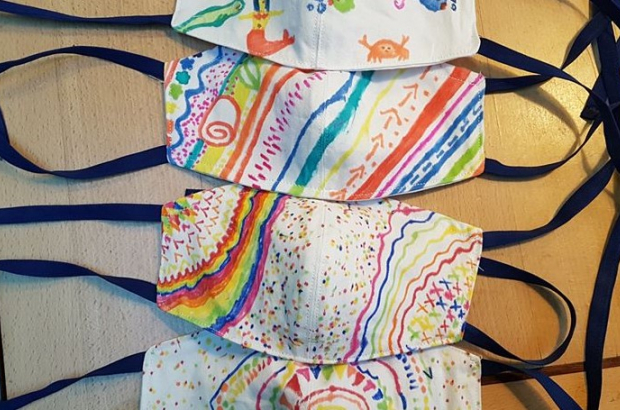- Daily & Weekly newsletters
- Buy & download The Bulletin
- Comment on our articles
Recording quarantine history as it happens
At the beginning of the corona virus pandemic, staff at the Ghent City Archive decided to look back to the influenza pandemic of 1918 and see how their city had fared. The result was not very encouraging.
“We couldn’t find much information,” says Nele Lefever, who is in charge of communication and public participation at the archive. “So we decided to collect information now about how people are reacting to the crisis, so that in 100 years’ time our colleagues don’t have the same problem.”
Ghent is not alone in archiving the response to the coronavirus. Projects have sprung up across Flanders, in cities such as Bruges, Hasselt, and Antwerp, and in smaller towns such as Mol and Izegem. There are also initiatives in Brussels and a number of Wallonian cities.
They have been supported by the professional associations for archivists in Belgium, the VVBAD in Flanders and the AAFB in French-speaking Belgium. Together they have set up the Quarantine Archive to share inspiration and practical advice.
“The first, simple idea was to create awareness among archivists and archival services that this is a special period, and to say: Don’t forget to grab hold of it,” says Willem Vanneste, archivist at Antwerp University and head of the VVBAD’s archive section.
Quarantine Archive gives advice about how this can be done and examples of organisations that have projects under way. There is a particular emphasis on tools that help archives capture digital material from websites and social media, which are changing rapidly in this period and in danger of disappearing once the crisis ends.
“In the old days we could sit back in our offices and wait until the paper came our way,” Vanneste says, “but in the digital age, archivists have to go out and make sure that digital information is preserved properly.”
Corona diaries
Ghent City Archive took the initiative early on. “We didn’t want to wait,” says Lefever. “We wanted to launch the project at the beginning of the crisis, so that we could capture everything about it. If we waited, people might already have thrown things away, or forgotten them, or not kept their diaries.
It put out a call in late March for people to send in corona diaries, in the widest sense: personal stories, poems, songs, photos, videos, blogs, vlogs and journals, drawings and artworks. The response has been good, with around 150 people making contact so far to contribute to the archive.
Some make one contribution, others send regular updates or have promised to send in their diaries once the crisis is over. “We have donations from researchers, students, young mothers, people who are retired, photographers, colleagues and teachers. So it is very diverse.”

Some contributions have already been posted on the archive’s Facebook page, to inspire others to get involved. They include a video of accordionist Wim Claeys performing on his doorstep, cartoons, poems, and photographs, for example of homemade face masks or a message to absent pupils put in a school’s window.
Then there have been the quirkier contributions. Dancepointe in Assenede sent in a video of a corona dance, in full protective equipment. And one story had distinct erotic overtones. The story itself “wasn’t really corona-related,” says Lefever, but “apparently people also write these kinds of stories in corona time.”
The project is open-ended at the moment, but later in the year the archive will start to think about what it has collected and how the material should be preserved. “We’ll get back to everyone for more information about their material and to ask what they want us to do with it. They get the option, for example, to keep it private for a set period, maybe even 100 years.”
The archive itself has no specific projects in mind for the material. “It’s for historians in the future to decide what the value of this archive is, and what they want to report about this crisis,” Lefever says.
In his role as university archivist, Vanneste also tries to avoid second guessing what future historians will need. “My own tactic is to take as much as we can handle, and then see later if everything needs to be kept.” For instance, social media channels may be spreading the same messages or videos, so there is scope for eliminating duplicates and identifying original sources.
He also has a clear focus on the university as an institution and a community. “At the moment I keep every mail from our rector and every digital newsletter because they are all about the crisis – what changes are needed and what the exit strategy might be.”
Plans are also being made for future collecting, to make a comprehensive corona archive. “For instance, a few of our professors are actively involved in national crisis management, so, after the dust has settled, we will contact them and ask if they have material to give us on this crisis period.”
Donate now
Meanwhile FelixArchief, Antwerp’s city archive, has teamed up with the MAS museum to collect both digital and paper artefacts, but also objects. This might be a sheet painted with a message supporting hospital staff, or a sign saying that a shop or school is closed because of the virus.
And naturally they are interested in homemade face masks or other protective equipment. The call for donations is open until 30 June.
“Hopefully this exceptional chapter in our lives will pass, but that doesn’t mean we should forget it,” said Nabilla Ait Daoud, Antwerp city councillor for culture. “Our museums and heritage institutions are well placed to preserve all kinds of objects and memories, and so open them up for future generations.”
Photos: Citizens are sending in photographs documenting some of their corona-related experiences and observations
©Liene Bruneel/Ghent City Archive (top), MAS museum (above)

















